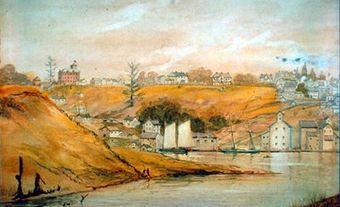Ancaster, Ont, Urban Community within the city of Hamilton. Ancaster was incorporated as a town in 1974, but in 2001 it was merged into the new city of Hamilton. Ancaster was named in 1793 by Augustus Jones, the surveyor of the township, after the parish of Ancaster in Lincolnshire, England. It was first settled in the 1790s. During the War of 1812 renegade settlers operating in the area were captured and charged with treason. At "The Bloody Assize" held in Ancaster, 15 of the 19 charged were found guilty, and of those 8 were executed and 7 exiled. By the 1830s Ancaster was the commercial centre for the area, but soon suffered several setbacks. In 1832 the opening of the Desjardins Canal in Dundas, Ancaster's neighbour and rival, was a blow to Ancaster. Likewise the town was bypassed by the railway, which went to Hamilton. While its role as a commercial hub was over, agriculture ensured Ancaster remained a vibrant community.
The Niagara Escarpment runs through the community. Along much of the escarpment lies the Dundas Valley Conservation Area which protects part of the Carolinian forest of southern Ontario. Many historic buildings, most notably the Old Town Hall (1871) and Griffin House (c pre-1850), as well as the Fieldcote Memorial Park and Museum, are local attractions.

 Share on Facebook
Share on Facebook Share on X
Share on X Share by Email
Share by Email Share on Google Classroom
Share on Google Classroom



